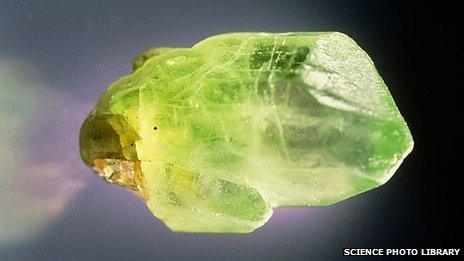Hydrogen squeezed from stone could be new energy source
- Published

Scientists from the University of Lyon have discovered a new way to split hydrogen gas from water, using rocks.
The method promises a new green energy source, providing copious hydrogen from a simple mixture of rock and water.
It speeds up a chemical reaction that takes geological timescales in nature.
In the reaction, the mineral olivine strips one oxygen and hydrogen atom from an H2O molecule to form a mineral called serpentine, releasing the spare hydrogen atom.
The results were discussed at this week's meeting of the American Geophysical Union in San Francisco, and have been published in the journal American Mineralogist.
The researchers heated olivine minerals in water to a couple of hundred degrees Celsius, and added a little bit of ruby (aluminium oxide) to the mix to provide a source of aluminium atoms.
The whole mix was placed into a miniature pressure cooker, formed of two diamonds, that squeezed the mixture to 2,000 atmospheres pressure.
The transparent diamonds allowed the scientists to watch the reaction take place.
The process occurs, albeit very slowly, in the rocks that form the ocean floors around the globe. In these natural settings it is thought that the hydrogen that is produced either reacts with carbon to form methane, or is used by microbes that live deep in the rocks to sustain life deep beneath the Earth's surface.
It is not yet clear exactly how much of this non-biologically generated methane is being produced within rocks across the planet.
Olivine is a common green mineral, sometimes mined as the semi-precious stone "peridot". The serpentine mineral that forms from it is beloved of sculptors and is often used as a decorative facing stone for buildings.
The mineralogists at Lyon were expecting the reaction to take weeks, if not months, so having set the experiment running one afternoon they were shocked to discover that half of the olivine crystal had already reacted when they took a look at it the next morning.
They realised that the addition of aluminium, dissolved from the ruby crystal, was key, speeding up the rate at which the olivine crystals dissolve in water and new serpentine minerals grow. Any source of aluminium could be used, and at the lower temperature experiments the researchers also used bauxite.
Describing their finds, Dr Isabelle Daniel told BBC News: "Serpentinisation is very common in nature and occurs along mid-ocean ridges.
"Hydrogen is measured at all the hydrothermal vents from these places and a huge amount of hydrogen and methane is produced: it is a general feature of the mid-ocean ridges. It is a major source of energy for chemo-synthetic bacteria in rocks."
Scouring CO2
At the moment, the production of hydrogen is mostly performed by a process called steam reforming, combining hydrocarbons like gas or oil with water at around 700 to 900 ˚C.
The new method uses much lower temperatures and involves no fossil fuel. This type of "green chemistry" promises a route to new sources of carbon-free energy at low environmental cost.
The experiments suggest serpentinisation could provide a possible long-term sustainable energy source. "If you were to process around 10% of the current hydrogen production by this method it would require a volume of rock similar to that used for cement production today," said Dr Daniel.
An interesting further application of the serpentine that is produced by this reaction, is the capture of atmospheric carbon. Serpentine in nature is known to actively scour CO2 by carbonation, and has previously been suggested as a feedstock for sequestering atmospheric carbon on a global scale.
There is evidence that weathering of olivine to serpentine in nature has, in the geological deep past, played a part in controlling atmospheric CO2.
- Published28 August 2013